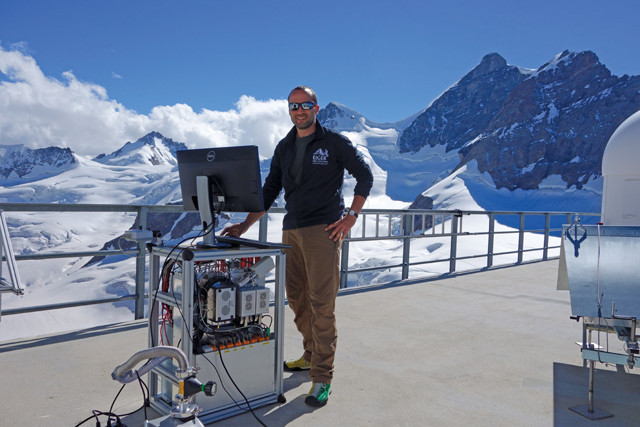
by Elizabeth Goldbaum Tuesday, September 13, 2016

Federico Bianchi and his colleagues analyzed air samples at Jungfraujoch Research Station in the Swiss Alps to study the formation of cloud condensation nuclei from organic compounds in the troposphere. Credit: Federico Bianchi.
In addition to their aesthetic and photogenic appeal, clouds play a crucial role in Earth’s climate and ecosystems, helping regulate temperatures by reflecting sunlight. All clouds — from fluffy cumulus to wispy cirrus — grow from seeds that, more often than not, are tiny particles of pollen, dust or chemical aerosols that float into the atmosphere from Earth’s surface. Sulfuric acid, a byproduct of volcanic eruptions and fossil fuel combustion, is one of the most ubiquitous precursors to atmospheric aerosols today and has long been thought to play a major role in modern cloud formation. But what about earlier in Earth’s history, before humans impacted the atmosphere as much? Three new studies, representing both experimental and field data, suggest that the planet’s plants and trees might have done just fine on their own pumping cloud-forming aerosols into the skies.
Two of the new studies, both published in Nature and making use of experiments run at the CERN particle physics laboratory on the French-Swiss border, reveal that cloud-seeding aerosols can form from organic molecules rising off trees without the aid of sulfuric acid. Jasper Kirkby, an experimental particle physicist at CERN, helped design the Cosmics Leaving OUtdoor Droplets (CLOUD) experiment, which makes use of a 3-meter-tall stainless steel tank in which scientists can replicate atmospheric conditions. Kirkby, lead author of one of the new Nature studies and a co-author of the other, and his colleagues observed how organic molecules released by trees can react with atmospheric oxidants other than sulfuric acid, such as ozone, to create seeds from which clouds can grow.
“One of the most important things we found was that [significant amounts of] aerosol particles will form in the atmosphere without requiring any human pollution,” Kirkby says. Consequently, Earth’s preindustrial atmosphere may have had brighter, more extensive cloud cover than previously thought, Kirkby says, a finding that suggests that current climate models may not properly account for the net cooling effect of clouds prior to the Industrial Age.
The new studies improve on earlier observations of how organic compounds contribute to aerosol growth early in the process, says Jeffrey Pierce, an atmospheric scientist at Colorado State University who was not involved with the studies. The results will likely impact preindustrial climate model simulations because areas previously thought to be reliant on sulfuric acid to produce aerosols could, in fact, have been producing them with organic compounds, he says. Therefore, the preindustrial climate may have had similar cloud coverage to today’s climate.
The findings could also affect the accuracy of model projections of future climate. “The more you reduce anthropogenic pollution, the more the biosphere — trees — will have an effective way to [compensate and] continue to make particles, which can then grow and become the seeds for cloud droplets,” Kirkby says.
Meanwhile, a new study in Science seems to corroborate the experimental results, showing the same processes at work near a mountaintop in the Swiss Alps. Researchers led by Federico Bianchi, a chemist formerly at CERN and now at the University of Helsinki in Finland, analyzed air samples at the Jungfraujoch Research Station, which sits at about 3,500 meters in the Swiss Alps. He and his colleagues recorded very low concentrations of sulfuric acid, but high levels of plant-derived organic compounds, suggesting the latter is mainly responsible for aerosol formation in Earth’s troposphere, where most clouds are formed, Bianchi says.
Data from Jungfraujoch indicate that organic compounds can form aerosols without help from sulfuric acid, Bianchi says, adding, however, that it’s important to double-check the observation in other locations because the content of the troposphere isn’t constant around the world. Mountains and valleys affect air circulation, which in turn affects how much pollution is in the air, Bianchi says. He says he plans to collect and test air samples from mountain stations near Mount Everest in the Himalayas and in the Bolivian Andes.
Although the new studies show that tree- and plant-derived organic volatiles can become aerosols without assistance from sulfuric acid and indicate that these materials might have significantly influenced preindustrial climate, they do not quantify the impact the organic compounds had. “It’s very hard to know exactly how cloudy it was before industrialization,” Kirkby says.
Researchers can determine past carbon dioxide concentrations from direct measurements where available or by using records from ice cores and other proxies, but reliable evidence for past aerosol concentrations is scant, which complicates paleoclimate modeling. If cloud cover in preindustrial skies were comparable to what it is currently, it’s possible that Earth’s climate is less sensitive than we think, Kirkby says, with increased greenhouse gas levels having raised global average temperatures just 0.8 degrees Celsius since the beginning of the Industrial Age without any appreciable change in the impact of clouds. On the other hand, if preindustrial skies were less cloudy than they are now, which has been the prevailing hypothesis, the implication is that Earth’s climate is more sensitive, he says, as the warming has occurred despite the added cooling effect of sulfuric acid-derived aerosols.
To quantify the potential impact of a cloudier preindustrial period, the researchers will turn to modelers, Kirkby says, because “there isn’t a simple way of using a proxy like ice cores to tell you what cloudiness was like.”
© 2008-2021. All rights reserved. Any copying, redistribution or retransmission of any of the contents of this service without the expressed written permission of the American Geosciences Institute is expressly prohibited. Click here for all copyright requests.